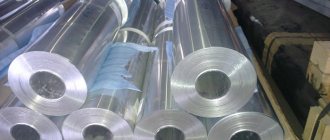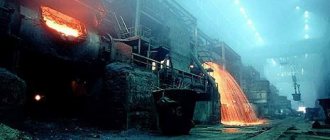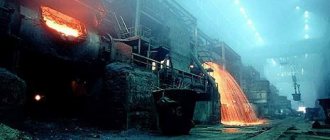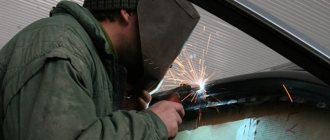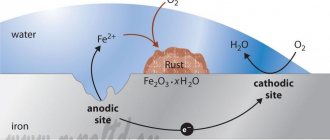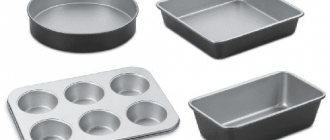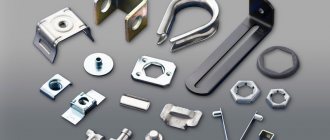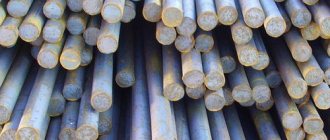VARIETIES AND SIZES OF PROFILE ASSORTMENT
| Profile | Mode of production | Size, mm |
| Circle | Rolled | 8,0-190,0 |
| Forged | 80,0-550,0 | |
| Square | Rolled | 10,0-190,0 |
| Forged | 80,0-450,0 | |
| Band | Katanaya | 6-20×30-50 |
| Forged | 25-300×300-800 | |
| Calibrated rods (silver) | Cold drawn | 2,0-35,0 |
How welded analogues are made
In order for products to be of the highest quality, it is necessary to adhere to the following scheme during their production:
- forming flat blanks into the shape of a pipe;
- welding;
- cleaning of welds;
- design testing;
- calibration process;
- cutting of finished pipe elements.
What types of welded risers are there?
The appearance of such risers is due to the use of furnace welding, electric arc welding, and welding in inert media.
I would like to note that simple welding has been replaced by modern joining methods. These primarily include laser and plasma technology, as well as the connection of individual parts using induction currents or using directed electron beams operating in a vacuum.
Depending on the presence, as well as the location of the welding seams, risers can be divided into straight-seam and spiral-shaped. It is logical that a spiral-shaped trajectory is characteristic of the 2nd type of parts. In the first option, the seam is placed along the pipe.
As experts emphasize, spiral-type parts are better and more reliable. In addition to these positive properties, they are also easy to repair, which is of great importance for most potential customers.
Moreover, longitudinal cracks cannot form on spiral-shaped elements.
Significant disadvantage:
greater tension when compared with straight-seam analogues. This property may cause extra costs.
Where was it used?
Most corrosion-resistant welded elements are used in industry and in everyday life. They are not suitable for installation of pipelines with high pressure and high temperature loads.
But even so, stainless steel parts are used:
- in public utility structures;
- in construction;
- when arranging water pipelines, since such pipes are completely hygienic and ideally environmentally friendly.
Food, chemical, petrochemical and many other industries also use corrosion-resistant steel weldments.
Stainless steel welded elements are an important part of locking fittings. They can often be found in construction, but not necessarily in the form of parts of large structures, but as individual cylindrical parts.
In addition, stainless steel risers are used as parts of the base of a building structure.
Modern residential buildings, shopping malls, exhibition pavilions - this is not a complete list of objects where you can see attractive stainless elements.
Application of stainless steel
The range of stainless steel products includes various products that are used in the following areas:
- production of floorings for the installation of staircases, technical platforms at industrial and other facilities;
- production of roofing elements, as well as decorative panels used in interior decoration, manufacturing of furniture and equipment;
- production of exhaust systems, fuel tanks, tanks, and other automotive components;
- production of fasteners - bolts, nuts, studs, self-tapping screws;
- Oil and gas industry;
- aerospace industry, machine tool industry, shipbuilding, energy.
Features of operation
Structures made from profile stainless steel pipes do not lose their load-bearing capacity and presentable appearance over time. They do not need painting and can be easily washed with household chemicals that do not contain chlorine. Dried stains cannot be scraped off or removed with a wire brush: use only a soft cloth or foam sponges.
Possible problems
In some cases, rolled stainless steel may be subject to corrosion. Foci of rust appear on the walls of products after prolonged contact with a concentrated chlorine solution. To eliminate the cause of corrosion, it is necessary to thoroughly rinse off the chlorine-rich liquid. The rusting process of stainless steel parts will slow down, and they will retain their anti-corrosion properties.
Packaging, transportation and storage
For ease of transportation, profiled stainless steel pipes are bundled or tightly placed in wooden containers lined with waterproof paper. The packages are tied with wire or metal tape in three or four places depending on the weight. For strapping during loading and unloading operations, bags and containers are equipped with special clamps.
They can be transported by any type of transport. The packages are placed on the floor of the car or in the body of the car in stacks, separating the rows with spacers.
Profile stainless steel products are stored on racks in closed warehouses or under a canopy, where they will be protected from atmospheric moisture.


